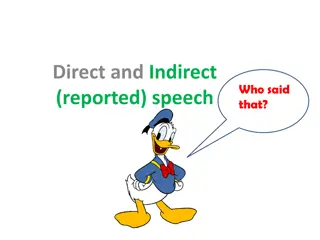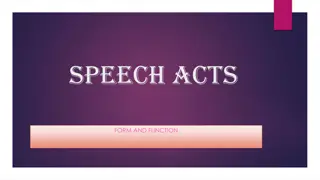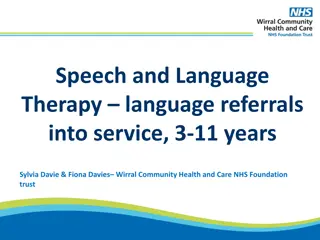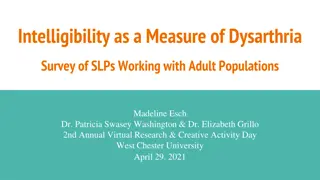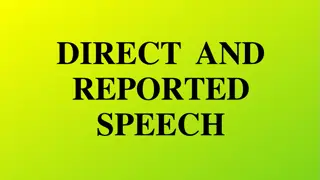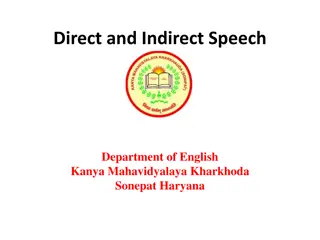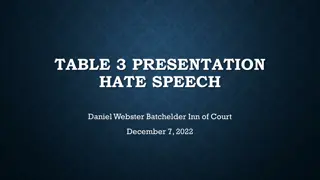Speech Therapy and Assessment for Students with Clefting
Speech Therapy and Assessment for Students with Clefting presented by Loretta Dunkmann, MS, CFY-SLP, covers the anatomy and physiology of clefting, types of clefting, assessment procedures including obtaining background information, oral mechanism exams, and analyzing speech samples. The content emphasizes the importance of surgeries in resonance issues, detailed examination methods, and perceptual assessments for hypernasality detection.
Download Presentation

Please find below an Image/Link to download the presentation.
The content on the website is provided AS IS for your information and personal use only. It may not be sold, licensed, or shared on other websites without obtaining consent from the author. Download presentation by click this link. If you encounter any issues during the download, it is possible that the publisher has removed the file from their server.
E N D
Presentation Transcript
Speech Therapy for students with Clefting Loretta Dunkmann, MS, CFY-SLP
Anatomy and Physiology Clefting is not about what happens; it is about what does not happen.
Alveolar ridgeforms sulcus between hard palate and lip Hard palate formed by medial projections of the palatine process of the maxillary bone suture at midline Palatine process is anterior of hard palate Posterior paired palatine bones
Obtain Adequate Sample Background Information Important that surgeries are included they play a role in resonance Oral Mechanism Exam A thorough exam may explain resonance issues Standardized Assessment For Qualification Reasons Peripheral Speech Assessment Connected Speech Sample Hypernasality may only be noticed during connected speech Specialized sampling contexts (sensitive to cleft type speech errors) Handout attached
Oral Mechanism Exam Note all the things you usually note Tonsils? Lip scars? Palate scars? High arched palate? Palatal Lift? Malocclusion?
Analyze Speech Sample Rate Overall intelligibility Document phonetic inventory Document speech resonance Document nasal air emission Classify errors
Perceptual Assessment - Hypernasality Too much nasal resonance Causes: Persisting VPI Fistula Intermittent suggests: Sporadic closure of VP port Assimilation nasality (affected by nearby nasal consonants) Continuous suggests: Physically based VP problem Refer to Quick Check
Hyponasality/Cul de sac Resonance Hyponasality: too little resonance Could suggest: Large adenoids Obstructive pharyngeal flap Intranasal airway obstruction Recent Cold Allergies Cul-de-sac Resonance: blind pouch sound is trapped by the anterior nasal cavity constriction Deviated septum
Airflow Direction Nasal Emission - results from the abnormal coupling of oral and nasal cavities. Airflow that normally is directed and emitted orally is allowed to escape into the nasal cavity and is emitted nasally. - nasal turbulence audible nasal emission audible snorting posterior nasal frication nasal rustle Causes: Obligatory: VPI and/or fistula Learned: phoneme-specific nasal emission: affects production of certain high-pressure consonants while the remainder of the HPCs are produced correctly Most vulnerable: sibilant fricatives and affricates /s, z/ sh zh ch j Persisting postoperative nasal emission
Collaboration Get the parents to sign a release allowing you to communicate with their medical team. I would like for school clinicians to feel that they are a part of the medical team, and for them to be in regular contact with the team SLP. They are the clinician closest to the child, who knows the child best and is in the child's day to day world. The team SLP is not. The team cannot provide optimal care without collaboration from the school or community SLP. Share your evaluation report and IEP with the medical team.
For any neurologically normal child born with a cleft, the expectation is for NORMAL SPEECH
Errors Obligatory errors: Errors that are caused by structural or neurogenic problems Such as Fistulas VP insufficiency These errors require physical management Learned Errors Habituated errors that are the result of early mislearning. They exist and persist in the context of adequate VP closure and required speech remediation. AKA: Maladaptive errors Compensatory misarticulations
Purposes of Early Speech-Language Stimulation Program (Phillips, ) To develop the child s confidence in ability to achieve intelligible verbal communication To ally parental anxiety concerning the child s development of verbal communication To encourage development of communication skills to the maximum of the child s potential --Structural ability to produce consonants influences early lexicon (Willadsen, 2013). To minimize or prevent development of compensatory articulation and voice patterns To determine velopharyngeal competence as early as possible
Encourage parents to respond to child with prolonged vowel sounds or front sounds as oppose to back noises. No growling No car noises
Depending on extent of the cleft, child may selectively avoid the hard palate as a key articulator, preferring to produce sounds that do not require linguapalatal contacts. Coupling of the nasal and oral cavities will impound intraoral air pressure resulting in distorted productions, avoiding productions of /b/ and /d/ during babbling Chronic middle ear infections accompanying conductive hearing loss All these factors can influence the sounds that the baby chooses to produce therefore resulting in the compensatory techniques we work on correcting.
School Based Therapy Errors we can work with Maladaptive compensatory productions Backed oral productions Pharyngeal stops, fricatives, affricates Glottal stops Nasal air emission Obligatory errors we cannot correct: Nasal emission and hypernasality caused by VPI Nasal air loss caused by fistulas Adaptive oral misarticulations resulting from structural abnormalities or severe malocclusions
School Based Therapy When To Start: Frequency & Duration Daily Basis that would be awesome but not realistic Twice weekly 30 minutes sessions Preferably 1:1 Supplement with daily speech homework/home practice program Get these answers: Understand child s hearing status Functional status of VP mechanism Oral structural hazards to speech progress Plans for ongoing team care
School Based Therapy Teaching Correct Oral Airflow Blowing bubbles Whistles Blowing against cotton balls Blowing through a straw Nose pinching **Note: these are not to be used as oral motor exercises, this is strictly to teach the student correct air flow movement.
School Based Therapy Therapy Approach Traditional Articulation Therapy Isolation Syllables CV, VC, CVC, VCV Words Initial medial final Phrases Sentences Reading Tasks Lynn Marty-Grames recommends 100% accuracy at each level before progressing. Resource Eliciting Sounds Techniques and Strategies for Clinicians 2ndEdition Wayne A. Secord (2007)
School Based Therapy Target Sound Selection Target errors that have the greatest impact on speech understandability and acceptability This could mean going out of developmental sequence Stimulability Visibility Place of production Anterior sounds first Manner Fricatives will typically be easier than stops
Children with clefts make a variety of articulation error types Not all errors are compensatory errors There are four speech sound categories in cleft palate speech, we will talk about these shortly.
If the child with a cleft needs braces, you can work on articulation, especially [s], until after orthodontics is completed. Most often, the error is the result of what the tongue is doing, not the position of the teeth. Diagnostic therapy should always be attempted. Certain orthodontic appliances may complicate speech therapy, depending on what you are working on.
If the child has velopharyngeal dysfunction, you cant work on articulation until after surgery. VPD alters airflow, not articulatory function. While some children develop maladaptive patterns, not all do.
What could articulation therapy do? It may show us that velopharyngeal management is not needed. It may prepare the child for valid imaging studies. It will make the child s speech more intelligible. It s possible to have completely normal articulation and still be hypernasal. In some cases, articulation therapy must take place before velopharyngeal imaging. Refer to a cleft team speech pathologist with a velopharyngeal imaging lab instead!
Delaying articulation therapy delays speech normalization. The better the articulation, the better the intelligibility after VP management If the velopharynx is dysfunctional, it will be dysfunctional across the phoneme spectrum If only a certain few sounds come out the nose, and the others don t . It probably is an articulation problem your problem! Mild forms of VPI may only manifest in the complexity of conversation Sometimes, the velopharynx can push closed for short utterances, but can t sustain over time.


![Prevention and Combating of Hate Crimes and Hate Speech Bill [B.9B.2018]](/thumb/60513/prevention-and-combating-of-hate-crimes-and-hate-speech-bill-b-9b-2018.jpg)






